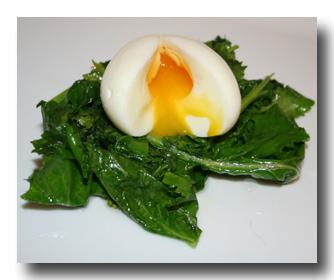|
OVERVIEW
The
chicken egg consist of a protective, oval eggshell, the albumen
(egg white), the vitellus (egg yolk), and various thin membranes.
Nutritionally, eggs are considered a good source of protein and
choline. Egg
white contains approximately 40 different proteins with Ovalbumin
(54%), and Ovotransferrin 12% being the major components. Ovalbumin
begins to set at 180F/80C while Ovotransferrin only begins to
set when heated to 140F/60C. Egg yolks contain lipoproteins which
coagulate at about 158F. Coagulation occurs when proteins lose
their native, soluble structure, so that they become insoluble.
ANIMATION
EXPLAINING WHY
EGG PROTEINS COAGULATE
 |
An
egg cooked at 150F results in a solid egg white but yolk remains
liquid. |
AVERAGE
TEMPERATURES THAT EGG PROTEINS COAGULATE
145°F/63°C
-- Egg whites begin to thicken
150°F/ 65°C--Egg whites become a tender solid although
ovomucin yolk cords will coagulate much higher. The yolk protein
starts to thicken.
158°F/70°C--
Egg yolks set.
165°F/73°C--
Whole egg sets. If eggs are cooked at 212F for too long they get
rubbery as proteins continue to coagulate and water is pushed
out from between protein molecules.
Project
Ideas
Using
a standard cooking thermometer practice keeping the temperature
of a pot of water constant for values from 140F-212F. . This is
easier if you have an electric stove, but using a gas stove on
a low flame will also work.
Cook
eggs at different temperatures ranging from 140F- 212F. Compare
how the different proteins have changed. This can be done visually
taking down careful notes, but it's best if a digital camera
is available to take photos.
Be
sure to discuss this project with your teacher and parents concerning
any safety issues. If you plan to eat the eggs be sure to follow
Food Safety (see reference below).
More
Advanced Techniques
Break
the eggs and separate the yolk from the white. Add them to plastic
bags or small glass containers which are heat resistant. This
will allow you to heat the yolk and egg white separately at different
temperatures. This method will also allow you to change the pH
and or salt concentration of the egg mixture providing an additional
variable (See below, Effect of Ph and Temperature on Protein)
for reference.
Additional
Ideas
Do
the proteins in older eggs coagulate at different temperatures
than fresh eggs?
What
effect does changing the pH have on the temperature that egg proteins
coagulate?
What
effect does changing salt (NaCl) concentration have on the temperature
that egg proteins coagulate?
NOTE:
MAKE SURE TO DISCUSS ANY SCIENCE PROJECT YOU DECIDE TO DO WITH
PARENTS AND TEACHERS BEFORE YOU BEGIN.
REFERENCES:
Effect
of pH and Temperature on Protein
Egg
Nutrition
Anatomy
of a Chicken Egg
Science
of Eggs
Food
Safety
| 
